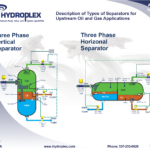Separator dump valves control the level of liquid within the vessel. The valves allow liquid to exit from the vessel within a set span. In a three-phase separator, the separator divides the incoming fluid stream into oil, and natural gas, and water phases. The gas is typically vented off the top of the vessel, while the oil and water are drained from separate outlets.
The exact design and configuration can vary depending on the specific requirements of the operation. A lower-level controller senses the oil-water interface maintaining water level and the upper sensor maintains the oil production. The controller signals the separator dump valves to release as much water and oil from the vessel as needed to maintain the predetermined oil and water levels to allow for efficient production.
Types of Dump Separator Valves
Two-Phase Separator Dump Valve
Within a two-phase separator, a snap switch or controller signals the liquid dump valve to open or close, or modulate. In snap mode, once the liquid in the vessel reaches a high enough level, the switch will trigger and send a pneumatic or electric signal to the separator dump valve, causing it to open and dump fluid from the separator within a specified span. In the modulating mode, the controller with maintain level within a specified tolerance by regulating the dump valve orifice.
Three-Phase Separator Dump Valve
Three-phase separator dump valves are used to “separate” produced well fluids into their individual components: oil, water, and gas. The function can be either on/off (Snap) or continuous flow (Modulating). Valve actuation can be either electrically or pneumatically controlled.
Dump Valve Separator Solutions
The Hydroplex Minimax “dump” valve plays a crucial role in the operation of two or three-phase separators. The Minimax separator dump valve is a highly adaptable control valve engineered to meet a wide range of pressure and flow control requirements, both complex and simple.
Its robust modular design ensures durability and straightforward maintenance. The valve’s convertible nature makes it easy to install. The end plug is convertible with both angle body 90- degree and inline setups. The valve trim and stem are fully guided, ensuring stability, reducing vibration, and decreasing mechanical noise.
The disc’s free-floating design provides an ANSI Class IV shut-off. The Twin Disc system is capable of handling full pressure drops. The valve’s simple construction allows for easy and fast maintenance without the need for specialized tools.
Longevity and Easy Maintenance
The valve has a sturdy modular design that ensures durability and performance. You can easily access and replace the internal cartridge assembly without the need for specialized tools or training.
Easy Installation
The valve’s adaptability allows you to install it in any configuration. You can convert the end plug for both 90-degree angle body and inline configurations, depending on your preference.
Stability and Noise Reduction
The valve trim and stem are fully guided, which prevents vibration and mechanical noise. The disc’s free-floating design achieves an ANSI Class IV shut-off, which ensures a tight seal and prevents leakage.
High Pressure and Flow Control
The Twin Disc system can handle high pressure drops in both liquid and gas applications. The Twin Disc design separates the control and sealing surfaces, which prolongs the life of the valve. The solid tungsten carbide trim minimizes wear and tear on the valve.
Superior Resolution and Accuracy
The 90-degree rotary Twin Disc trim provides precise and consistent control in any application. The high repeatability rate maintains unparalleled control and efficiency.
The Hydroplex Minimax dump valve provides superior performance in the separation process, ensuring the efficient separation of gas and liquid phases.


